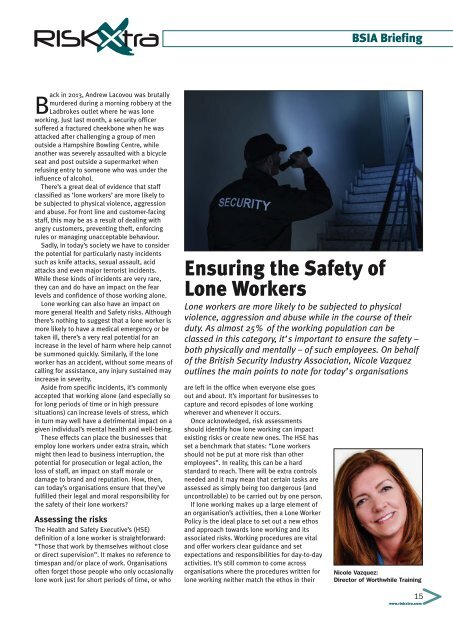RiskXtraDecember2018
You also want an ePaper? Increase the reach of your titles
YUMPU automatically turns print PDFs into web optimized ePapers that Google loves.
x<br />
RISKXtra<br />
BSIA Briefing<br />
Back in 2013, Andrew Lacovou was brutally<br />
murdered during a morning robbery at the<br />
Ladbrokes outlet where he was lone<br />
working. Just last month, a security officer<br />
suffered a fractured cheekbone when he was<br />
attacked after challenging a group of men<br />
outside a Hampshire Bowling Centre, while<br />
another was severely assaulted with a bicycle<br />
seat and post outside a supermarket when<br />
refusing entry to someone who was under the<br />
influence of alcohol.<br />
There’s a great deal of evidence that staff<br />
classified as ‘lone workers’ are more likely to<br />
be subjected to physical violence, aggression<br />
and abuse. For front line and customer-facing<br />
staff, this may be as a result of dealing with<br />
angry customers, preventing theft, enforcing<br />
rules or managing unacceptable behaviour.<br />
Sadly, in today’s society we have to consider<br />
the potential for particularly nasty incidents<br />
such as knife attacks, sexual assault, acid<br />
attacks and even major terrorist incidents.<br />
While these kinds of incidents are very rare,<br />
they can and do have an impact on the fear<br />
levels and confidence of those working alone.<br />
Lone working can also have an impact on<br />
more general Health and Safety risks. Although<br />
there’s nothing to suggest that a lone worker is<br />
more likely to have a medical emergency or be<br />
taken ill, there’s a very real potential for an<br />
increase in the level of harm where help cannot<br />
be summoned quickly. Similarly, if the lone<br />
worker has an accident, without some means of<br />
calling for assistance, any injury sustained may<br />
increase in severity.<br />
Aside from specific incidents, it’s commonly<br />
accepted that working alone (and especially so<br />
for long periods of time or in high pressure<br />
situations) can increase levels of stress, which<br />
in turn may well have a detrimental impact on a<br />
given individual’s mental health and well-being.<br />
These effects can place the businesses that<br />
employ lone workers under extra strain, which<br />
might then lead to business interruption, the<br />
potential for prosecution or legal action, the<br />
loss of staff, an impact on staff morale or<br />
damage to brand and reputation. How, then,<br />
can today’s organisations ensure that they’ve<br />
fulfilled their legal and moral responsibility for<br />
the safety of their lone workers?<br />
Assessing the risks<br />
The Health and Safety Executive’s (HSE)<br />
definition of a lone worker is straightforward:<br />
“Those that work by themselves without close<br />
or direct supervision”. It makes no reference to<br />
timespan and/or place of work. Organisations<br />
often forget those people who only occasionally<br />
lone work just for short periods of time, or who<br />
Ensuring the Safety of<br />
Lone Workers<br />
Lone workers are more likely to be subjected to physical<br />
violence, aggression and abuse while in the course of their<br />
duty. As almost 25% of the working population can be<br />
classed in this category, it’s important to ensure the safety –<br />
both physically and mentally – of such employees. On behalf<br />
of the British Security Industry Association, Nicole Vazquez<br />
outlines the main points to note for today’s organisations<br />
are left in the office when everyone else goes<br />
out and about. It’s important for businesses to<br />
capture and record episodes of lone working<br />
wherever and whenever it occurs.<br />
Once acknowledged, risk assessments<br />
should identify how lone working can impact<br />
existing risks or create new ones. The HSE has<br />
set a benchmark that states: “Lone workers<br />
should not be put at more risk than other<br />
employees”. In reality, this can be a hard<br />
standard to reach. There will be extra controls<br />
needed and it may mean that certain tasks are<br />
assessed as simply being too dangerous (and<br />
uncontrollable) to be carried out by one person.<br />
If lone working makes up a large element of<br />
an organisation’s activities, then a Lone Worker<br />
Policy is the ideal place to set out a new ethos<br />
and approach towards lone working and its<br />
associated risks. Working procedures are vital<br />
and offer workers clear guidance and set<br />
expectations and responsibilities for day-to-day<br />
activities. It’s still common to come across<br />
organisations where the procedures written for<br />
lone working neither match the ethos in their<br />
Nicole Vazquez:<br />
Director of Worthwhile Training<br />
15<br />
www.riskxtra.com>

















